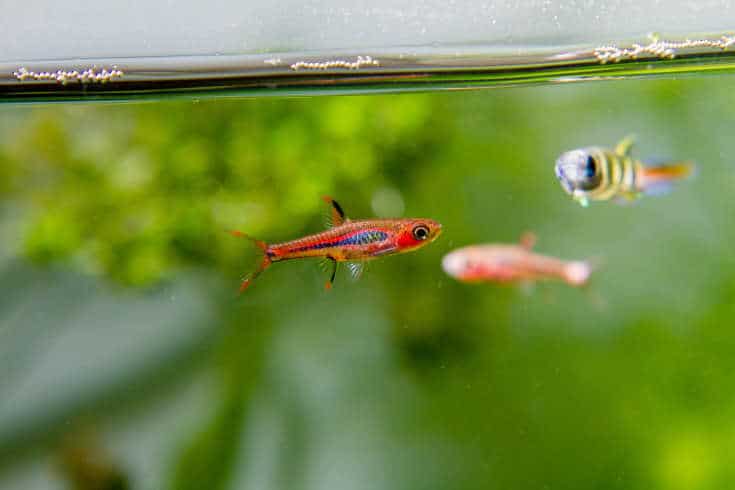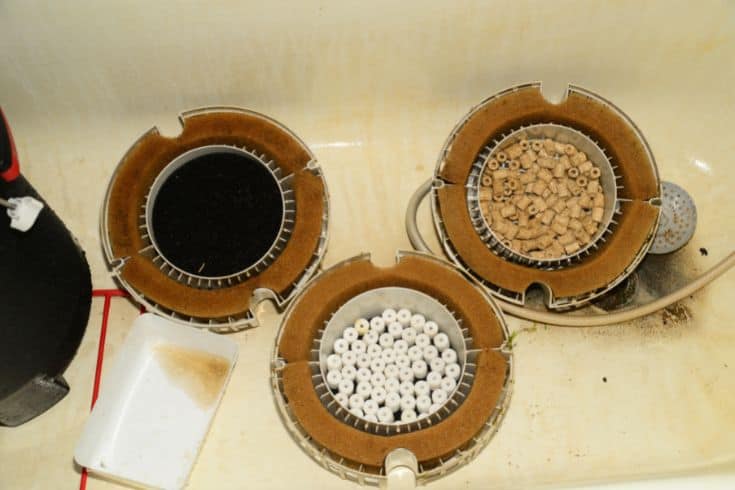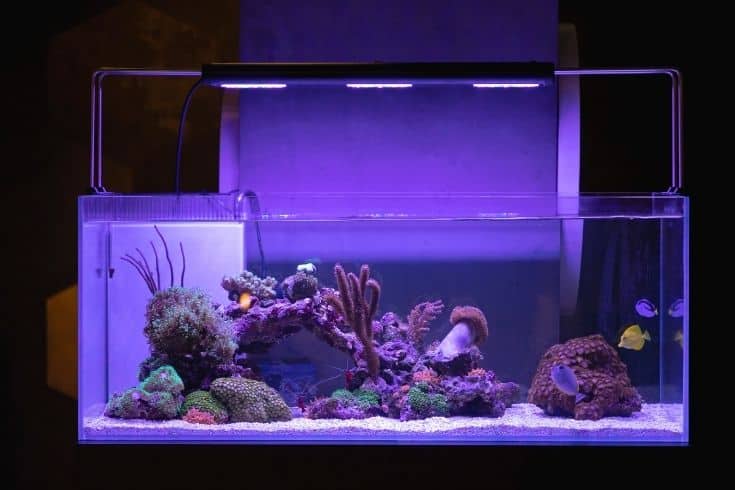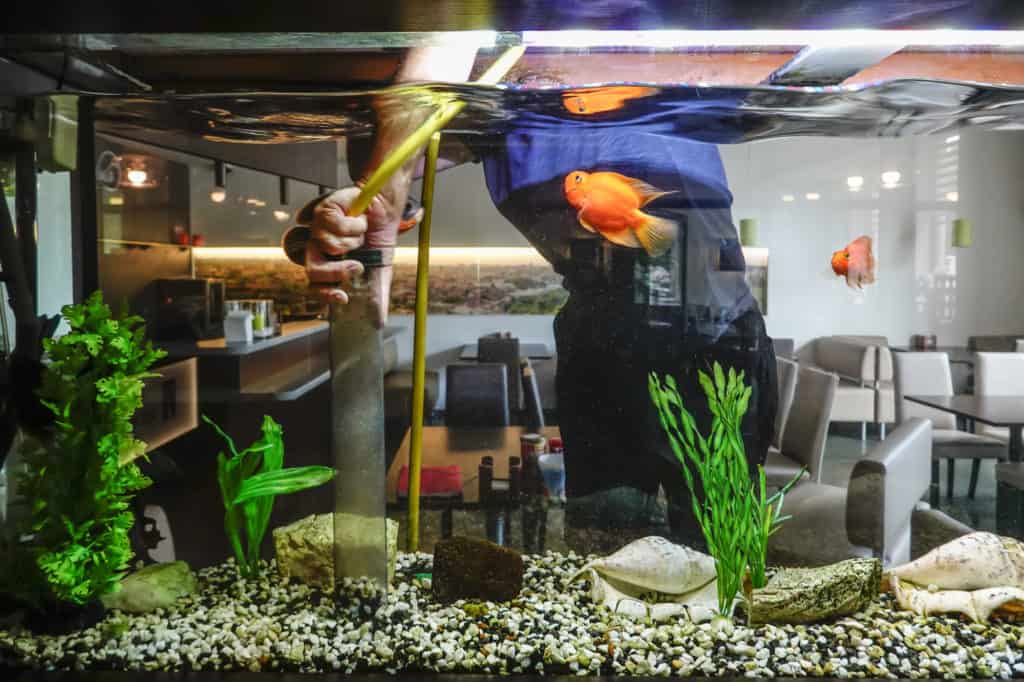The Chili Rasbora is a small tropical aquarium fish that makes a bright and beautiful addition to any peaceful community fish tank.
Sometimes known as the Mosquito rasbora, these tiny, brightly-colored fish are just half an inch long, making them the ideal choice for a small community aquarium. Chili rasboras do well when kept in company with other suitable tank mates, although the fish’s sensitivity to fluctuations in water parameters makes them unsuitable for beginners.
Read this guide to learn how to care for these tiny swimming gems.
Chili Rasbora – Overview
Scientific Name
Boraras brigittae
Common Name (species)
Chili rasbora, Mosquito rasbora
Family
Characidae
Origin
Southern Borneo, Indonesia
Diet
Omnivore
Care Level
Moderate
Activity
Active, shoaling species
Lifespan
6 to 8 years
Temperament
Peaceful fish
Tank Level
Mostly swims in the middle to upper areas of the aquarium
Minimum Tank Size
5+ gallons
Temperature Range
Tropical 68° to 83° Fahrenheit
Water Hardness
1 – 10 dKH
pH Range
4.0 to 7.0
Filtration/Flow Rate
Prefers a low water flow rate
Breeding
Easy to breed in captivity. Egg layer
Compatibility
Does well with small, compatible tank mates
OK, for Planted Tanks?
Safe with plants
Chili Rasbora Origins
Chili rasboras were discovered relatively recently in 1978 in the mosquito-filled, heavily forested areas of Southwestern Borneo, which is where the fish gets its other common name, Mosquito rasbora.
These fish belong to the Actinopterygii class of ray-finned fish, specifically, the Characiformes order that contains 17 families, including the Chili rasbora.
Natural Habitat
Chili rasboras are found in the Indonesian provinces of Kalimantan Selatan and Kalimantan Tengah and parts of Southwest Borneo. Here, the fish live in blackwater pools and streams, where the water current is slow, and the water is peat-stained and low in salts and minerals. In fact, the water pH can be around 4.0 or even lower.
The Rasbora’s habitat is naturally dimly lit, heavily vegetated, and littered with leaf litter, submerged branches, and roots.

Appearance
Chili rasboras are tiny fish, measuring just half an inch long. However, their bright red coloration can look beautiful when presented in a shoal.
The fish are a deep red color with dark markings on the body and fins, highlighted by a crimson stripe.
How Big Do Chili Rasboras Get?
Chili rasboras only grow to around half an inch long. Chili rasboras grow extremely quickly, usually reaching their full size within just a few months.
Life Expectancy
The Chili rasbora’s lifespan is between six and eight years.
Activity Level/Temperament
These are very active fish that love to shoal together in the midwater area of the water column.
Compatibility And Tankmates
Chili rasboras are peaceful, timid fish that make a nice addition to a community aquarium. These fish will shoal with other small species, such as tetras, Cherry shrimp, gouramis, and other rasboras, and pygmy corydoras also make good companions for them.
You should avoid keeping large, aggressive fish that might make a meal of the rasboras.
Can I Put Chili Rasboras With A Betta?

Yes. Chili rasboras and bettas are regarded as nano fish that don’t need a huge tank to be happy. Betta fish can be territorial and aggressive, but the two should get along fine as long as you provide plenty of lush planting for the rasboras to hide in.
How About Chili Rasboras With Neon Tetras?
Chili rasboras can live with most kinds of tetra fish. However, since the rasboras are smaller than the neons, you must ensure that they are not outcompeted for food.
Can You Keep Rasboras With Shrimp?
Chili rasboras are peaceful fish that usually get along well with shrimp since the rasboras are too small to eat adult and baby shrimp.
Can Chili Rasboras Live Together?
Chili rasboras need to live in large groups of eight to ten individuals. These fish naturally school together or shoal with other similar-sized fish. If kept in small groups, the rasboras can become shy and spend most of their time hiding away among your aquatic plants.
Diet and Nutrition
Chili rasboras are omnivores, eating different types of food, including plant matter and meaty protein.

Since even the adult fish are so tiny, you need to find a staple food that’s small enough for them to eat.
Finely crushed tropical fish flakes, micro pellet formula, and nano pellets are all good choices for a basic diet, but you can make that more interesting for the fish by including frozen baby brine shrimp, daphnia, and tiny bloodworms.
How Much and How Often to Feed
I recommend that you feed the rasboras twice daily, offering them different types of food to keep their diet interesting and varied.
It’s better to feed your fish two small meals than one large one, as that makes it easier for the rasboras’ digestion to process the food.
If you can’t be there to feed your fish at the appointed time, you could buy an automatic fish feeder that has a timer feature.
Tank Requirements
Chili rasboras are not difficult to care for, although you must keep the water parameters stable.
Tank Size
Chili rasboras are a great choice for nano tanks. That means you can keep a school of ten of these gorgeous little fish in a 5-gallon aquarium.
However, if you have a larger tank, you can create an even more dazzling display and include lots of suitable tank mates for your nano fish, too.
Aquarium Setup
To enable your fish to thrive, you must try to recreate the conditions of their natural environment as closely as possible.
Substrate
We recommend using a dark substrate to make the Chili rasboras colors really shine! Fine gravel or sand is a close match to the rasboras’ natural river bottom home, and it comes in colors such as black or dark gray.

To replicate a blackwater habitat, you need to scatter a layer of dried Indian almond leaves over the substrate. As the leaves break down, they leach tannins into the water, turning it the color of tea and lowering the pH, making the conditions ideal for Chili rasboras.
Decoration
To mimic the rasboras’ natural home, you should use plenty of dense plants that the fish can use for shelter, as well as a mix of driftwood, caves, stones, and twisted roots.
Remember not to clutter the tank too much so that the fish have plenty of swimming space where they can school together.
Plants
These tiny fish need dense planting to replicate the conditions found in their natural habitat. The rasboras are shy fish that need to have somewhere to hide when they want to.
As well as being necessary for your rasboras, plants are great for the aquarium. Plants take up nitrates from the water, use CO2, and give off oxygen, helping to keep the environment safe and well-oxygenated for your fish.
Chili rasboras need well-oxygenated water to thrive, and including a range of aquatic plants in your setup can help to provide that.
Habitat Requirements
Filtration

Chili rasboras live in rivers and pools with a very low to moderate flow. So, if your filter creates too much water movement, your fish could struggle to swim.
I always find that a sponge filter works well with these tiny fish since that creates a low flow and removes the danger of the fish being sucked into the filter unit.
Water Parameters
Chili rasboras come from a habitat with very specific water conditions, which you need to replicate in the aquarium if the fish are to survive and do well.
Water Temperature
The ideal water temperature for Chili rasboras is between 68° to 83° F, so you’ll need to include a reliable heater in your setup.
Water Chemistry
Blackwater habitats typically have very soft water with low levels of salts and minerals. So, ideally, the water in your tank should have a pH between 4.0 and 7.0.
Lighting

The water bodies Chili rasboras inhabit are dimmed by the overhanging tree canopy and banks of thick shoreline plants.
I always use floating plants to create dappled shade and diffuse the aquarium lighting if I have fish that prefer a darker environment. You might need to choose low-light plants that can cope with dimly lit conditions for the rest of your aquascape, but there are plenty to consider.
Tank Maintenance
You need to keep your setup well-maintained and clean if your rasboras are to thrive. The main reason for mass fish deaths is unstable water conditions, so check the water parameters regularly using an aquarium testing kit and make any necessary adjustments promptly.
Perform Partial Water Changes
Each week, carry out 10% to 15% partial water changes to keep ammonia, nitrite, and nitrates at acceptable levels. Ammonia and nitrites should be zero, while nitrates should not exceed 20 ppm.
Use An Aquarium Vacuum
When carrying out your weekly water changes, use an aquarium vacuum cleaner to get rid of fish waste, dead plant matter, and uneaten fish food from the substrate.

You should snip off dead plant leaves, broken stems, and overgrowth, and remember to replace the almond leaves when required.
Maintain Filter Media
Every couple of weeks, remove the filter media from the filter unit and rinse it in tank water to remove any sludge that could clog the impeller and prevent flow through the filter unit.
You’ll also need to replace spent filter media periodically in line with the manufacturer’s directions.
Setting Up the Aquarium
First of all, assemble everything you need for your aquarium:
- Dark substrate
- Dried almond leaves
- Lighting unit
- Filtration system
- Heater
- Aquarium thermometer
- Driftwood, twisted roots, stones, etc.
- Floating and low-light plants
How to set up your aquarium:
- Rinse the substrate under running water to get rid of dust and debris.
- When the water runs clear, can add two to three inches of gravel to your fish tank and sprinkle a few dried almond leaves across the substrate. That will create a blackwater habitat when you add water to your tank.
- Install your heater and filter, but don’t turn them on yet.
- Fill your tank with dechlorinated tap water. Put an upturned plate on top of the substrate so that the gravel doesn’t get displaced when you pour the water over it.
- Rinse your tank decorations, and put them into your tank.
- Snip off dead plant leaves and damaged stems before placing the plants in your tank, allowing plenty of space for growth.
- Activate the filter and heater, and allow the tank to cycle for a couple of weeks. Test the water every couple of days with an accurate water testing kit, only adding your Chili rasboras once the water chemistry is correct.
We recommend adding only a few nano fish to a newly cycled tank at first to prevent overloading your filter and triggering an ammonia spike that could kill your fish. After a couple of weeks, you can add more fish, provided the water chemistry remains stable.
Health and Disease
Although Chilli rasboras are reasonably hardy, they do not tolerate fluctuations in water chemistry or poor water quality. So, if you keep conditions in the tank stable, there’s a better chance that your fish will remain healthy.
Signs of Good Health
Healthy Chili rasboras are lively fish that spend much of their day schooling in the midwater area of the water column or exploring your plants and tank decor.
Red Flags
Red flags that could indicate health problems for your Chili rasboras include the following:
- Poor appetite
- Lethargy
- Hanging at the water’s surface
- Swellings, sores, and red areas on the body
- Rubbing against solid objects in the tank
Health Issue
Ich (White Spot Disease)
Symptoms or Causes
Ich is a very common disease that’s caused by an aquatic protozoan parasite.
Fish infected with Ich develop a sprinkling of tiny white spots on their fins, gill covers, and bodies. They also flash against the gravel and other solid objects in the aquarium.
Suggested Action
Raise the water temperature to 82o F for three days. Use an OTC White Spot Disease medication to treat the tank.
Health Issue
Flukes
Symptoms or Causes
Flukes is the term used to describe various types of external fish parasites. These macroparasites can often be seen with the naked eye attached to the fish’s skin or gills.
Suggested Action
Treat the fish tank with an OTC antiparasitic medication.
Health Issue
Fungal infections
Symptoms or Causes
White fluffy growths on the fish’s body, mouth, and head.
Suggested Action
Quarantine infected fish, and treat with an antifungal medication.
Health Issue
Bacterial infections
Symptoms or Causes
Sores and ulcers on the body and head, ragged, bloody fins.
Suggested Action
Treat the tank with OTC antibacterial treatment.
Breeding
You don’t really need a separate breeding tank to breed Chili rasboras. These nano fish are straightforward to breed in your main tank since they don’t eat their eggs as some fish species do.
In fact, in a single-species tank, any fry that appears has a good chance of surviving as they will hide among your plants until they’re large enough to join the school confidently.
Spawning
Breeding fish can be a fun hobby that all the family can join in with, and Chili rasboras are a great place to start.
Although it’s almost impossible to differentiate between the sexes of these tiny fish, if you buy a group of eight to ten rasboras, you’re certain to end up with a mixture of males and females. As soon as the fish are mature, spawning is pretty much instantaneous.
When the female fish deposits her eggs, they drift to the tank bottom, where they will hatch after 36 to 72 hours. Immediately on hatching, the fry is free-swimming, needing no parental care from the adults.
You can feed your Chili rasbora fry on commercial fry food and infusoria until they can cope with baby brine shrimp and similar foods. Your Chili rasbora babies are sexually mature at six months old.
Availability
Chili rasboras are sometimes found in fish stores, or you can buy them online for around a couple of dollars each.
As is the case with most small fish species, most suppliers offer a discount if you buy a large group, making that the best way to go.
Product Recommendations:
- Aquarium (minimum size 5 gallons)
- Filtration system
- Heater
- Aquarium thermometer
- Water conditioner
- Lighting unit
- High-quality tropical flake food
- Selection of frozen foods
- Dark gravel substrate
- Decorations
- Books on keeping tropical fish
- A fish net
- Aquarium vacuum
- Algae magnet
Final Thoughts
Did you enjoy our guide to caring for the swimming jewel that is the Chili rasbora? If you did, please take a moment to share the article.
Chili rasboras are beautiful little fish that can make a sparkling addition to a peaceful community setup. These fish are sensitive to fluctuating water parameters, so we don’t recommend them for complete beginners to the hobby. However, if you have an established blackwater tank and you can ensure that the water quality remains stable, these enchanting fish could be well worth considering.
Do you keep Chili rasboras? What compatible tank mates do they have? Tell us in the comments box below!
